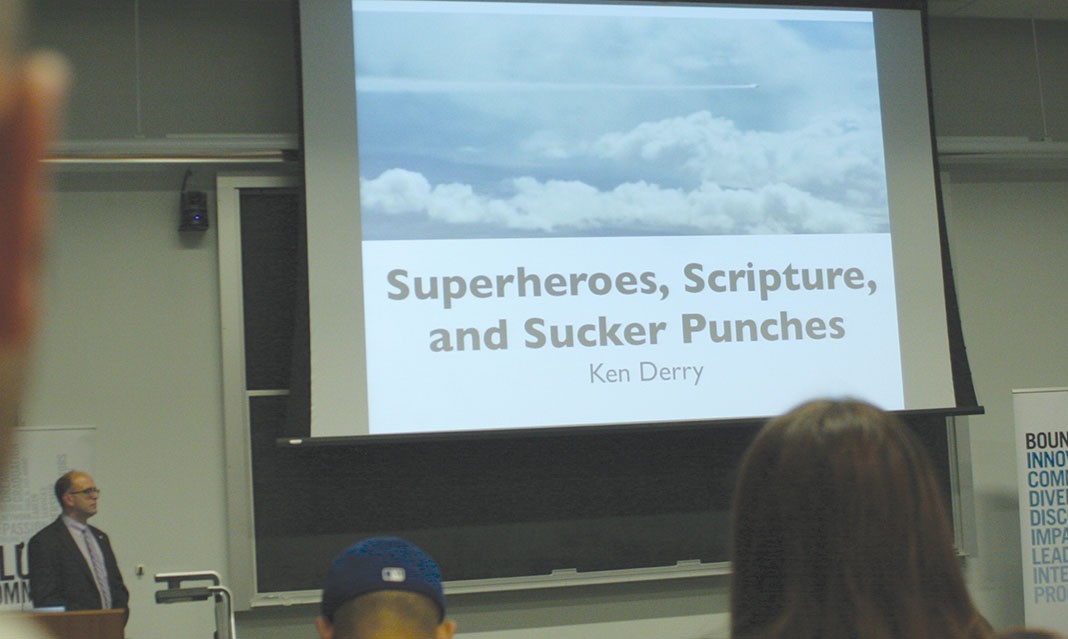With Halloween around the corner, I’m preparing to see a number of masks and costumes of various characters. To identify whom the outfit represents, I ask myself the following: Is the character a saviour? Are they invincible? Are their origins mysterious? Do they disregard the law while fighting for justice? If all the answers are yes, I know that I’m looking at a superhero.
However, after attending the Alumni Development Network’s “Classes Without Quizzes” event last Wednesday, I realize a superhero is not the only identification that I’m working towards. The character depicted with the attributes listed may very well be the figurative depiction of Jesus Christ.
Let’s take a look at 3 B.C.—a time when the world was wrought with major problems, such as the migration amongst the Babylonians and Syrians. The Bible was the major resource for advice in that region.
Robert Jewett and John Shelton Lawrence, authors of Captain America and the Crusade against Evil, have divided biblical responses to crises into two categories: politics and our beloved superheroes. Throughout the talk, our host Ken Derry, a religion studies professor, drew a parallel between these two categories.
Before we dive deeper into these categories, let’s do a thought experiment. When being faced with a problem in your society, do you reflect upon your contribution? Does your approach include working with the law and spreading the love? Do you find yourself often forgiving your enemies? If you said yes to any of these questions, your ideas may be what are referred to as prophetic realism. Congratulations! You may find your parallel in Thor or Batman—only in The Dark Knight, that is.
While those are decent comparisons, you—and your parallel characters—endure a lot of suffering. Batman works with the legal system and fights to maintain Harvey Dent’s heroic impression. We all know about those characters doing the self-righteous killing, but Batman doesn’t want us to lose faith in the legal system.
“If existing legal structures aren’t sufficient to address the problem, then you work together to change those structures,” says Derry when describing prophetic realism. However, he goes on to say, “The other response is the opposite of all of those things.”
Distinguishing between the good guys and the bad guys—or demonizing the enemy—is the kind of self-righteous behaviour we can expect from those individuals who supersede existing legal structures to enforce justice. This ideology is referred to as zealot nationalism and is also the most commonly encountered superhero narrative.
In contrast with the prophetic realism hero examples provided by Derry, he further describes zealot nationalism. “Most superheroes are vigilantes. They’re technically criminals, but in their own stories, where it’s justified breaking of the law in order to achieve a greater good.”
“Often what you end up with in the narrative—the zealot nationalist narrative—is the kind of story where you’re left with no choice but to actually destroy your enemies; that’s not necessarily the starting point,” is the argument presented by Derry when describing the “redemptive violence” approach of a zealot nationalist. “You vilify or demonize your enemy and evil. You don’t start off with saying, ‘Well, we’ll get to destroying the enemy.’”
He describes the initial approach as, “We have to fight them, we have to use violence, but destruction often comes as a last resort.” Derry adds that “in many of the biblical stories, the destruction of the enemies is in fact the first thing they think of”.
Derry continues to mention significant examples from the Bible, as mentioned by Jewett and Lawrence, where a prophetic realism approach was adopted for correction of communities. He mentions a quotation regarding taking the log out of your own eye before removing a speck from the other’s in relation to self-reflection. A contrast is apparent in more apocalyptic biblical stories, where, as Derry describes, no one is going to sit down and have a conversation with the devil—he’s just going to be thrown into the fire.
“You end up looking to a saviour figure, either as an individual figure or a crew, or the nation itself,” says Derry in relation to the role of American politics and the self-righteous attitude they adopt towards superseding international agreements and imposing their idea of law and order.
Such similarities are evident in the portrayal of superheroes such as Superman and Iron Man as Christ figures. An important component to note is the number of times these heroes appear in the crucifix position in the movies, signifying their suffering and self-sacrifice. Derry displays several images of Superman in the crucifix position with a still frame where, while Superman is contemplating his decisions, a backdrop image of Jesus doing the same is shown.
Derry also notes the transformation of Tony Stark from a self-indulgent businessman to a zealot nationalist hero, after he has a literal change of heart in the terrorist cave, as parallel to being resurrected and transformed.
“I feel like these are things I was sort of unconsciously aware of while watching movies, but I wasn’t aware of the theory or the structure behind it,” says Ammarah Abid, a second-year life sciences student. “Now that I look at it, it seems so obvious. There’s so much more depth to superheroes than we give them credit for.”
Derry mentions how many people may describe his approach as “reading too much” into superhero movies, but he adds that “media literacy is important”.
“If we know these patterns are there, they won’t have so much of an effect. If you could see how you’re being manipulated, you probably wouldn’t be.”



